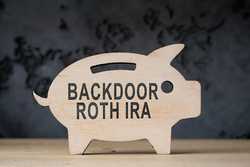- Easy to set up.
- No income or contribution limits.
- No withdrawal restrictions.
- Multiple investment options.
What Is A Custodial Account?

Our evaluations and opinions are not influenced by our advertising relationships, but we may earn a commission from our partners’ links. This content is created by TIME Stamped, under TIME’s direction and produced in accordance with TIME’s editorial guidelines and overseen by TIME’s editorial staff. Learn more about it.
If you'd like to start saving for college for your kids or simply give them a financial leg up, you might consider opening a custodial account—an investment account an adult manages for a minor beneficiary, such as a child or grandchild.
While the child technically owns the account's assets, the adult custodian manages contributions, chooses investments, and makes other account-related decisions. When the child reaches the age of majority—age 18, 21, or even 25, depending on the state—they become the account owner with full control over how the assets are invested and spent.
The two primary types of custodial accounts are set up in the Uniform Gifts to Minors Act (UGMA) and Uniform Transfers to Minors Act (UTMA). They make giving financial gifts to minors easy, as they don’t involve setting up a potentially expensive or complicated trust.
The main difference between an UGMA account and an UTMA account are the types of assets you can hold in it. An UGMA account can hold traditional assets, such as cash, stocks, bonds, mutual funds, exchange-traded funds (ETFs), annuities, and insurance policies. An UTMA account allows investing in both traditional and alternative assets, such as real estate and art. UTMA is now the account recognized by all U.S. states; accounts you set up now will be UTMAs. This shift does not affect existing UGMA accounts.
Money contributed to an UGMA or UTMA account is an irrevocable no-strings-attached gift to a designated child beneficiary. While the child owns the account's assets, the custodian ensures that the money is invested and used solely for the child's benefit. When the child reaches the age of majority, the custodian transfers the assets to the beneficiary, who takes over from there. Unlike some accounts, a custodial account must be in one designated minor's name, and that beneficiary can't change. Note that with an UTMA account, a child can also receive transfers from an estate, not just gifts from living people.
Like UGMA accounts, UTMA accounts have no contribution limits, making them valuable gift-giving opportunities for birthdays, celebrations, and other milestones. For 2024 parents, relatives, and friends can each contribute up to $18,000 ($36,000 for married couples) free of gift tax. Larger gifts will use up a portion of the contributor's lifetime estate and gift tax exemption, so people typically use trusts for giving more-substantial gifts.
UGMA and UTMA accounts are taxable investment accounts, and any income generated by their assets is subject to taxes in the year it's earned. A 1099 is issued in the minor's name (as the account's legal owner), though the form is usually sent to the custodian. For 2024, if the child is under 19 (or 24 for full-time students whose unearned income provides less than half of their support), then:
Advantages and disadvantages of a custodial account
A custodial account offers several advantages, including an easy account-opening process, zero income and contribution limits, and no withdrawal restrictions. Once the minor reaches adulthood, they can use the money for anything, from college to a down payment on a house. Most UTMA accounts offer a wide range of investments, including certificates of deposit (CDs), stocks, bonds, exchange-traded funds (ETFs), mutual funds, and access to alternative investments. [If you are dealing with an existing UGMA account (all new accounts will be UTMAs), you won’t be able to put funds in alternative investments.]
Any deposits or gifts made to a custodial account are irrevocable—you can’t take them back—so it's important to proceed carefully. In addition, you can't change the designated beneficiary, and all the account's assets are transferred to the beneficiary when they come of age. While up to $1,300 (for 2024) of earnings is exempt from federal income tax, UGMA and UTMA accounts generally offer limited tax advantages compared with other accounts.
Significantly, a custodial account can adversely affect a child's financial aid eligibility, because the account's assets are considered to be owned by the child.
In the United States, the rules for custodial accounts are controlled by states. As noted earlier, states have been replacing UGMAs with UTMAs, which offer more flexibility. Vermont and South Carolina were the last two states to switch. Any custodial account you set up for a minor now will be an UTMA. Existing UGMA accounts remain valid and follow the rules for that type of account.
You can open most custodial accounts online (UNest is one option) or in person at a bank or financial institution. The account must have a specific beneficiary, so you'll need the child's legal name, birth date, and Social Security number. There's usually no minimum to open an account, though you might have to meet minimums to invest in certain assets.
Once the account is open, parents, grandparents, and relatives can add money with no contribution limits. Apps such as Backer make it easy to boost savings with gifts from family and friends.
The custodian chooses the account's investments, such as stocks, mutual funds, and ETFs. They have a fiduciary responsibility to act in the minor's best interests.
Once the child reaches the age of majority, the custodian must transfer the assets and account control to the beneficiary, who can then invest and spend the money in the account however they choose, even if it goes against the custodian's wishes.
UGMA and UTMA accounts aren't the only way to invest in a child's financial future. A trust fund, 529 savings plan, Coverdell savings account, or Roth IRA may be a better option. It all depends on your situation.
A trust fund is typically more complicated and expensive to establish than a custodial account. A lawyer draws up a legal document called the "trust instrument," which specifies the rules of the trust including when and how the beneficiary will receive the funds. A trust fund may be a good option if the amount of money you want to set aside for the child is substantial or you wish to restrict how the beneficiary will use the funds.
A 529 plan lets parents and other interested adults save toward a child's college costs. Contributions grow tax free, and withdrawals are tax free when used for eligible educational expenses. While there are no annual contribution limits, 529 plans often have lifetime contribution limits.
A 529 plan has a few advantages over an UGMA or UTMA account. One is that you can transfer a 529 to a new beneficiary, provided they're a member of the original beneficiary's family, such as a sibling, spouse, parent, child, first cousin, niece, or nephew. Also, a 529 plan offers more-favorable tax treatment than an UGMA or UTMA account and has less impact on financial aid eligibility. And as much as $35,000 of 529 funds (lifetime limit) can be transferred to a Roth IRA. Consult with our recommended list of 529 plans to learn more.
Like a 529 plan, a Coverdell education savings account offers tax-free growth and distributions for qualified education expenses. Still, the account has a relatively low contribution limit: For 2024 the maximum contribution is $2,000 annually until the minor turns 18.
An ESA also has income limits, and you can't open or contribute to one if your modified adjusted gross income (MAGI) is more than $110,000 ($220,000 for married couples filing jointly). As with a 529 plan, you can change the beneficiary, and the account is considered an asset of the parent, so it has a low impact on financial aid eligibility.
A Roth IRA is one of the best investments for kids. It offers tax-free growth, as well as tax-free withdrawals in retirement, providing a tremendous opportunity for young people to take advantage of decades of compounding.
An adult can open a custodial Roth IRA for a minor and contribute up to $7,000 for the 2024 tax year provided that the child has earned income equal to the contribution amount. Per the Internal Revenue Service (IRS), the term “earned income” constitutes wages, salaries, tips, bonuses, commissions, and self-employment earnings. Once the child reaches a certain age (18 or 21, depending on the state), the assets must be transferred to a new account in their name.
A custodial account offers an excellent way for parents, relatives, and friends to save and invest on a child's behalf. With the right investments there's the potential for attractive growth and returns. However, a custodial account offers another valuable benefit: the opportunity to teach kids about money, investing, and establishing good financial habits. It allows a custodian to set a child up for financial success in the near future when they take control of the account.
Multiple adults can open custodial accounts for the same minor. Likewise, a single adult can open multiple custodial accounts for different beneficiaries. However, only one custodian and one minor are allowed for each custodial account.
Earnings are generally taxed at the child's tax rate, which is usually lower than the parents' rate. For 2024, if the child is under 19 (or under 24 for full-time students whose unearned income provides less than half of their support), then up to $1,300 of earnings is exempt from federal income tax, and the next $1,300 is taxed at the child's tax rate. Any earnings over $2,600 are taxed at the parent's marginal tax rate per "Kiddie Tax" rules.
A custodian can withdraw money from the account only if it's used for the direct benefit of the child. For example, you could tap into the account to pay for your child's private high school tuition. If you withdraw money, be sure to keep track of when and how you used it, filing the receipts somewhere safe. This way you'll have records in case anyone (including the minor) disputes how the funds were used.
Once the minor comes of age and takes control of the account, they can withdraw money and spend it however they choose.
When a child reaches the age of majority for an UGMA or UTMA account (between 18 and 25, depending on the state), the custodian must transfer the assets and control of the account to the beneficiary. In some states a custodian can elect to maintain control of the account until the child is older than the state's age of majority. However, the custodian must do so when opening the account, as changes can't be made later.
The information presented here is created by TIME Stamped and overseen by TIME editorial staff. To learn more, see our About Us page.



